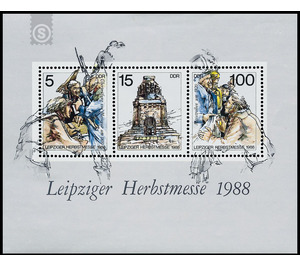Commemorative stamp series - Germany / German Democratic Republic 1988
Theme: Architecture
| Country | Germany / German Democratic Republic |
| Issue Date | 1988 |
| Item Type | Block |
| Chronological Issue Number | 3198 |
| Chronological Chapter | GER-DDR |
| SID | 838074 |
| In 15 Wishlists | |
Leipziger Herbstmesse 1988 On the occasion of the Leipzig Autumn Fair in 1988, the Ministry of Posts and Telecommunications of the German Democratic Republic issues a block with three multi-colored special postage stamps. No Special First Day Cover Cover Special cancellation from August 30 to October 29, 1988 Leipzig Autumn Fair 1988 The special postage stamps for the Leipzig Autumn Fair 1988 pay tribute to a world historical event that took place 175 years ago in and around Leipzig and to a large extent also near today's exhibition center. From 16 to 19 October 1813, the Battle of Nations raged here, marking the beginning of the final defeat of Napoleon. 190,000 troops of Napoleonic troops faced 306,000 soldiers of the allies - Russians, Austrians, Prussians and Swedes. They fought a fierce battle lasting several days. On October 18, 1813, at about four o'clock, Napoleon dictated the retreat order to Quandt's Tobacco Mill, his command post. Nearly 90,000 dead remain on the battlefield. In addition to 22,000 Russians, 16,000 Prussians, 12,000 Austrians and 300 Swedes also left 37,000 French their lives. Dedicated to the dead is the monumental Monument to the Battle of the Nations, which marks the end of the extended main axis of the fairgrounds - the street of 18th October. It was inaugurated on 18 October 1913 on the occasion of the 100th anniversary of the Battle of Nations. The idea of such a memorial soon arose after the battle and was expressed by many patriots. But it was only in 1894 by the Leipzig architect Clemens Thieme (1861 - 1945) founded "German Patriotic League for the establishment of a Battle of the Nations in Leipzig" took this idea consistently. He organized competitions for construction-ready designs and lotteries, collections of pennies and fundraising campaigns to raise the building costs, because the city and the state did not contribute to the costs. In 1898 the first ground was broken, in 1900 the foundation stone was laid. The construction lasted 15 years and never had more than 40 workers employed. The design was made by the Charlottenburg architect Bruno Schmitz (1858 to 1916), who was then considered the most important German monument artist and u. a. also the Kyffhäuser monument created. But the creator of the Völkerschachtdenkmal is Thieme, who refined the designs and, above all, promoted and secured their realization. In size and importance, the Monument to the Battle of the Nations is a unique memento. The massive structure forms an all-important focal point in the southeast of the trade fair city. The giant building, which is comparable to a pyramid, is considered Europe's highest modern monument. The 91-meter-high structure is built on a 30-meter high mound and stands on 65 main, intermediate and secondary pillars. The width at the foot is 124 meters. For the construction, it was necessary to handle 1 million cubic meters of earth and to process 120,000 cubic meters of tamped and reinforced concrete. 26,500 blocks of Beucha granite porphyry with a total volume of 12,500 cubic meters had to be brought in. Several sculptors were involved in the design of the outer fronts and the interiors. Today, the cyclopean, simple building, which is also prized as a testament to concrete construction at that time, is still a tourist attraction. 500 steps lead up to the platform, which offers a wide view of the Leipzig lowland bay. The middle of the three special postal stamps shows the front of the massive Völkerschlachtdenkmal, while the other two stamps depict the hustle and bustle at the Leipzig Trade Fair before and after the Battle of Nations - based on contemporary representations, according to Geissler. The Battle of Nations had a promoting influence on the Leipzig Fair. After Napoleon's conquest of the German lands as a result of his victory at the Battle of Jena and Auerstadt in 1806, the French arrived in Leipzig in October this year. The trade in trade fairs dropped considerably: from 6,700 visitors and 40,000 hundredths of goods turnover in 1806 to 3,600 visitors and 23,000 hundredweight in 1807. The continental blockade - which was probably inspired even by the English goods confiscated in Leipzig - left the European trade of the English, which was significant for Leipzig come to a standstill. The fear of the French occupying power and its charge of fire and war claims did the rest. After the Battle of the Nations, the Russian general Prendel became city commander. Above all, he took care that the Leipzig Trade Fair flourished again. Already the fairs in the year 1814 proved the upswing.


